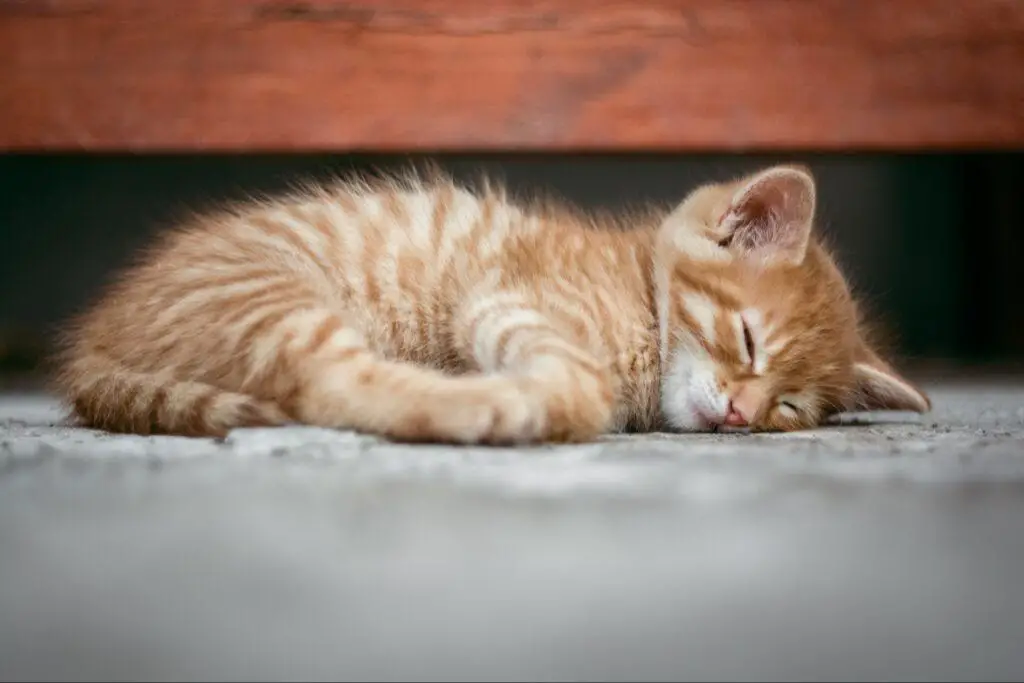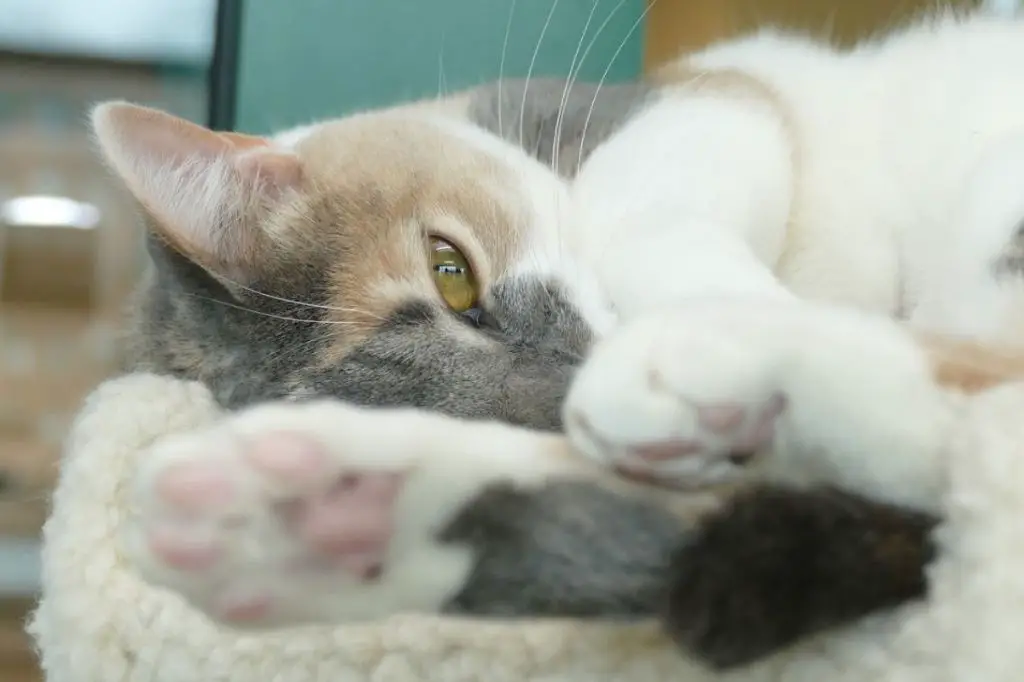Typical Cat Sleep Patterns
Cats are known for being excellent sleepers, with the average adult cat sleeping 12-16 hours per day [1]. They spend a large portion of their day alternating between light sleep and deep REM (rapid eye movement) sleep. Light sleep takes up about 70% of a cat’s sleeping hours, while deep REM sleep makes up the other 30% [2].
Kittens and younger cats need even more sleep than adult cats, sleeping around 16-20 hours per day as their growing bodies and minds develop. Senior cats, on the other hand, begin sleeping more as they age, averaging about 20 hours of sleep per day [3].
The light sleep phase allows cats to rest while still remaining alert to their surroundings. The deep REM phase is when cats experience vivid dreams, just like humans. Going in and out of these sleep cycles throughout the day allows cats to get the rest they need.
Why Cats Sleep So Much
Cats are crepuscular animals, meaning they are most active at dawn and dusk. Since they evolved as hunters, cats need to conserve energy during the day for hunting at peak times. Cats may spend 50% of their day asleep and over 80% inactive, per PetMD[1].

Kittens sleep even more than adult cats, needing 16-20 hours of sleep daily for proper development. Growing kittens expend a lot of energy playing and need abundant rest. According to the Sleep Foundation, kittens may sleep over 75% of the day[2].
For senior cats, excessive sleep may signal an underlying health issue. Older cats need monitoring for conditions like hyperthyroidism or kidney disease which could cause lethargy. An elderly cat sleeping 4+ more hours daily than usual requires a veterinary visit, advises PetMD[1].
Cat Sleep Locations
Cats tend to seek out locations that are safe, warm, and quiet when choosing a spot to sleep, whether indoors or outdoors 1. During the day, cats often nap in sunny spots like windowsills or patches of sunlight on the floor. Cat beds, especially ones with warming features, are also popular lounging locations. At night, most cats prefer to sleep in their owner’s bed, on furniture, or in their own cat bed 2.
While cats have some general preferences, each feline has unique quirks about where they like to sleep. Some cats always sleep in the same spot, while others regularly switch up their location. Observing your cat’s sleeping patterns can provide insight into their individual personality and preferences.
Signs of a Sleeping Cat
There are several telltale signs that indicate your cat is sleeping or napping. One of the most common sleeping positions is when cats curl up in a ball or into a loaf shape, with their paws tucked in and legs folded beneath them (https://www.purina.co.uk/articles/cats/behaviour/common-questions/cat-sleeping-positions). This allows cats to conserve body heat and protect their limbs and paws while resting. You may also notice your cat’s eyes are fully closed or half-open while sleeping. Cats often remain slightly alert in case they need to react to any sudden noises or movements. Their breathing will appear steady and rhythmic during sleep. You may see their whiskers or paws twitching as they dream. These are all common indications that your feline friend is getting some well-deserved rest.
Waking a Sleeping Cat
Cats tend to be very sensitive when sleeping and prefer to wake up naturally and slowly on their own terms. It’s best not to wake a sleeping cat unless absolutely necessary. However, sometimes you may need to gently rouse a cat, for example to give medication or move them to a different room.
The best way to wake a sleeping cat is through gentle stimulation like lightly petting their head or ears, or softly calling their name from a slight distance. Avoid making sudden loud noises or jostling the cat awake, as this will likely startle them. Cats can sometimes react aggressively when woken suddenly, even if they are normally docile. Always approach waking a sleeping cat with care and patience.
Let sleeping cats lie if possible, and allow them to wake up naturally. But use gentle, soothing contact like petting or calling their name if you need to rouse a napping kitty. Avoid abrupt noises or stimulation that could shock or frighten the cat. With patience and care, you can successfully get even the soundest sleeper to open their eyes.
Source: https://www.wikihow.com/Wake-up-a-Cat
Importance of Cat Naps
Cat naps are actually very important for a cat’s health and wellbeing. Though it may seem like cats sleep all day and are lazy, their frequent snoozing serves some key purposes.

Cat naps provide mental stimulation and help renew a cat’s energy levels. When cats sleep, their brains cycle through various stages just as human brains do. This allows their minds to process information and experiences from the day. Naps prevent mental fatigue and keep cats feeling refreshed.
Napping is also an instinctual need, not a sign of laziness. Cats are natural hunters designed to expend bursts of energy stalking prey, followed by resting periods. Frequent cat naps align with this biological rhythm. Cats conserve energy through naps so they are prepared for their next “hunting” adventure, whether it’s playing with a toy or getting the zoomies.
So while it may seem counterintuitive, cat naps are a form of active rest that supports optimal health. They provide the mental and physical rejuvenation cats need to thrive.
Creating a Cat-Friendly Home
Cats thrive in a home environment that is designed with their needs in mind. Here are some tips for creating a cat-friendly home:
Cats like to have access to warm, soft bedding where they can curl up and sleep comfortably. Provide beds in quiet corners or sunny spots around your home. Use cushions, blankets, cat beds, or cardboard boxes to create cozy napping areas (ICatCare).
Give your cat places to perch up high so they can observe their surroundings. Install cat trees, shelves, or window perches so your cat can climb and look out windows. Cats feel more secure when they can view their territory from above (ModernCat).

Cats are easily startled, so minimize loud noises. Try to keep things calm and peaceful. Make sure your cat has access to quiet rooms where they can retreat if needed.
Provide stimulation with toys and activities, but also ensure your cat has “alone time” in a designated nap spot. A cat-friendly home balances opportunities for play, sleep, and relaxation.
Signs of Excessive Sleepiness
One of the indications that a cat is sleeping more than usual or is too sleep might be observed through a drastic increase in sleep hours. Whereas the average adult cat sleeps 12-20 hours per day, a cat sleeping significantly beyond this range could signal an issue. It may become very difficult to rouse or wake the cat when it is in an overly deep sleep.
Lethargy is another clue that a cat is sleeping excessively. When the cat is awake during its normal active periods, it may seem very low energy and uninterested in playing or other typical activities. This lethargic behavior results from the excessive sleeping and lack of activity.
Excessive sleeping and lethargy when awake can be symptoms pointing to an underlying illness. Some of the potential medical issues that could cause a cat to sleep more include diabetes, hyperthyroidism, anemia, arthritis, dental disease, and cancer. It’s important to consult a veterinarian if a cat displays these behaviors to properly diagnose and treat any condition.
Sources:
Fun Facts About Cat Sleep
One of the most fascinating fun facts about cat sleep is that cats dream like humans do. During REM sleep, cats experience vivid dreams and their brain activity shows similar patterns to human REM sleep. While we don’t know exactly what cats dream about, their dreams most likely involve imaginary or past events and chasing prey.
Another interesting fun fact is that ancient Egyptians revered cat naps. Cats were considered sacred animals and allowed to sleep wherever they pleased. There were even special cat nap rooms in Egyptian homes to provide cats with a peaceful place to snooze.
The most well-known fun fact is that cats spend an extraordinary amount of their lives sleeping – about 70%. On average, cats sleep around 15 hours a day, with older cats sleeping up to 20 hours. Their frequent napping is a completely normal part of their daily routine.
Cats are such dedicated sleepers that they can sleep in some very unusual positions. The famous cat loaf, where a cat tucks in its paws and looks like a loaf of bread, is one of the most endearing sleeping positions. Understanding fun facts about how and why cats sleep so much can help cat owners better care for their feline friends.
The Importance of Playtime
Playtime is essential for a cat’s wellbeing. It provides necessary mental and physical stimulation that prevents boredom, depression, and destructive behaviors.
Playing allows cats to mimic their natural hunting behaviors and expend pent-up energy in a positive way. According to Catster, “Playtime is vitally important to a cat’s mental and physical health.”

Interactive play with toys or their human caregivers provides vital cognitive stimulation. As PetMD explains, it “improves cats’ mental health, too, lessening anxiety.” Mentally engaging play encourages curiosity and problem-solving.
Additionally, daily playtime provides crucial exercise for cats, especially indoor cats. Chasing toys and pouncing helps strengthen muscles, improve balance and coordination, and release excess energy. Keeping cats active through play maintains their physical health and prevents obesity-related issues.
In summary, playtime keeps cats happy and healthy by stimulating them physically and mentally in ways that mimic natural feline behaviors. Providing sufficient daily play opportunities is a key responsibility for cat owners. As Dreamiestreats states, “Playing with people and other pets helps our felines to socialise, form relationships and develop important skills.”

